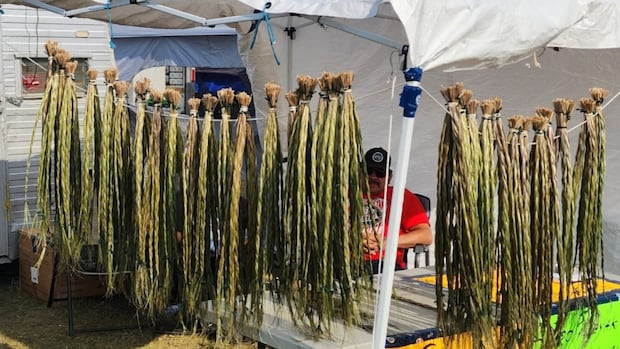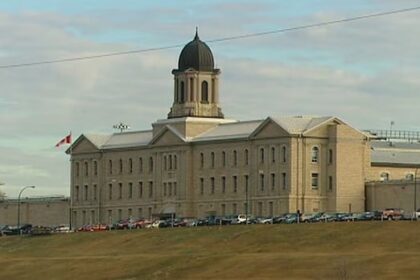SaskatchewanMembers from a northern Manitoba First Nation known as the “land of sweetgrass” have travelled hundreds of kilometres to share their harvest of the medicine.Sapotaweyak Cree Nation brings Indigenous medicine to gathering in Fort Qu’AppelleBrad Bellegarde · for CBC News · Posted: Sep 20, 2025 8:00 AM EDT | Last Updated: 3 hours agoMerle Munro’s camp and vendor location at the Treaty 4 Gathering powwow grounds, where he brings sweetgrass he has harvested near Sapotaweyak Cree Nation. (Submitted by Brad Bellegarde)Members from a northern Manitoba First Nation known as the “land of sweetgrass” have travelled hundreds of kilometres to share their harvest of the medicine.Ephrem Sakayigun is one of the members of Sapotaweyak Cree Nation who travelled to the Treaty 4 Gathering in Fort Qu’Appelle, Sask., this week, where the anniversary of the treaty signing has been recognized in annual gatherings for the last 30 years. Treaty 4 was signed on Sept. 15, 1874, at Fort Qu’Appelle, and Sapotaweyak signed on in 1876. The treaty territory covers about 195,000 square kilometres that includes most of present-day southern Saskatchewan plus a segment of west-central Manitoba and the southeast corner of Alberta.Sweetgrass — which is one of the four sacred Indigenous medicines along with cedar, sage and tobacco — has long been harvested in Sapotaweyak Cree Nation, which is about 400 kilometres northwest of Winnipeg.Sakayigun said that at home, they pick their sweetgrass at Kettle Hills, which is in the Swan-Pelican Provincial Forest, about 45 kilometres south of the reserve. The sweetgrass harvest is a five-day process that starts with an offering of tobacco and a prayer.”Then when we get home, we clean it, separate it. We only take sweetgrass.… We know exactly what we are taking.”Sophie, left, and Ephrem Sakayigun stand in front of their camp sign holding sweetgrass at the Treaty 4 Gathering campsite. (Submitted by Brad Bellegarde)Sakayigun said sweetgrass cleanses the air and spirit and offers safety for those who use it. But it is never sold casually. “We don’t put up signs like ‘sweetgrass for sale.’ That’s very disrespectful.”His wife Sophie braids it. This year, they brought 2,500 braids to the annual weeklong gathering.Longtime attendee Gary Gott is a knowledge keeper and member of Sapotaweyak Cree Nation. He said that sweetgrass is very important to First Nations people because it is a way to communicate with their ancestors.”When we started powwows we’d pick sweetgrass and sold it for $2 a braid,” he said.Near Sapotaweyak, sweetgrass grows abundantly due to the swampy landscape and lakes surrounding the reserve. In Saskatchewan, although sweetgrass can be found, the conditions are not as favourable for its growth due to the different types of soil. Merle Munro holds a large braid of sweetgrass at his vendor booth. (Submitted by Brad Bellegarde)Sapotaweyak Cree Nation member Merle Munro has been harvesting sweetgrass for six years. “I have a little one here. She helps me harvest it.… She braids it and she gets tired though,” he said with a laughFor Munro and many other community members, the annual gathering is not only a celebration, but also a way to pass teachings on to the next generation. “It’s important for them to know the culture, to know where it is and how it’s going to be preserved.”ABOUT THE AUTHORBrad Bellegarde is a freelance writer for CBC Saskatchewan. Born and raised in Treaty 4 Territory, he holds an Indian Communication Arts Certificate from the First Nations University of Canada and a Bachelor of Arts in Journalism from the University of Regina. Follow him on Twitter @BBellegardeCBC
This First Nation helps keep tradition of sweetgrass harvest alivein Treaty 4










